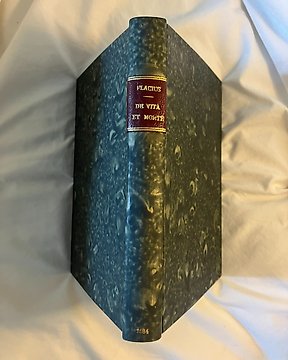
Matthias Flacius (‘the younger’) - Commentariorum physicorum de vita & morte libri IIII - 1584
N. 76698865

N. 76698865

Giovanni Francesco Olmo (Johannes Franciscus Ulmus/Ulmi or François Umeau), De certa ratione iudicandi ex urinis. Libri quatuor. Venice : Polum, 1578.
Octavo: (4), 94, (10, index) leaves.
FIRST edition, in modern card. A nice printing with historiated capitals.
Holdings: Three copies in USA. Minnesota, NYAM, Minnesota. Krivatsy Sixteenth Century: 3394.
By the time this work was published, uroscopy had become an integral part of learned medicine. Drawing on Aristotelian natural philosophy and Galenic theory, and series of medieval writers such as Avicenna, Michele Savonarola, Actuarius and Theophilus, as well as contemporaries such as Johannes Baptista Montanus (all referred to in the book) a writer like the Italian Giovanni Olmo had the basis for a highly sophisticated diagnostic – as well as a prognostic – tool.
So far as I can tell, Olmo uses uroscopy principally as a means to detect and identify a disease state as distinct from predicting the outcome of a disease state. But his coverage is broad and includes references to prognoses. He treats the smell, colour, consistency and clarity of urine; urinary sediments of various kinds, such as sand and stone; and the presence in urine of foam, scales, blood, pus, sperm and iron.
The claimed capacity by some of Olmo’s contemporaries to see dozens of tones and colours in urine (and in colour charts) led to much ribaldry amongst the opponents of uroscopy. But at a time when charlatanism was rife, Olmo appears to have been cautious and called his discipline ‘an most uncertain art’ (De certa ratione 89v) obtained a level of confidence from his peers and patients which historian Michael Stolberg describes as ‘clearly exceptional’.
A second feature which makes Olmo’s book of interest is that it does not slavishly follow the precepts set down in the Byzantine work of uroscopy by Johannes Actuarius. De urinis (Venice 1519, and then frequently republished during the sixteenth century). The work has been described by Garrison and Morton as the most complete and systematic study of the subject, so much so that it left hardly anything new to say. But in fact, Olmo is unsparing in his criticisms of Actuarius, including of his theory of concoctions both in the body and especially in the liver (De certa ratione 12r, 10v), that his account of hypostasis is inconsistent and largely incorrect (64-65) and that Actuarius failed to detect pregnancy in urine 88r).
This suggests that Olmo’s De certa ratione is more interesting than the common run of such treatises of the period. Certainly it is more thorough and well-established.
References:
Michael Stolberg, ‘The Decline of Uroscopy in Early Modern Learned Medicine (1500-1650)’, Early Science and Medicine 12/3 (2007): 313-36, page 332.
James Copland, A Dictionary of Practical Medicine (NYC 1859), article ‘Urine’, III: 1355 citing Olmo.
Camille Vieillard, L'urologie et les médecins urologues dans la médecine ancienne (Paris, 1903): 383, citing Olmo.
Faith Wallis, ‘Inventing Diagnosis..’, Dynamis 20 (2000): 31-73.
Erik Kouba et al, ‘ Uroscopy by Hippocrates and Theophilus: Prognosis Versus Diagnosis’, The Journal of Urology 177/1 (2007): 50-52.
Michael Stolberg, Uroscopy in Early Modern Europe (Farnham 2015).
Come fare acquisti su Catawiki
1. Scopri oggetti speciali
2. Fai l’offerta più alta
3. Paga in tutta sicurezza